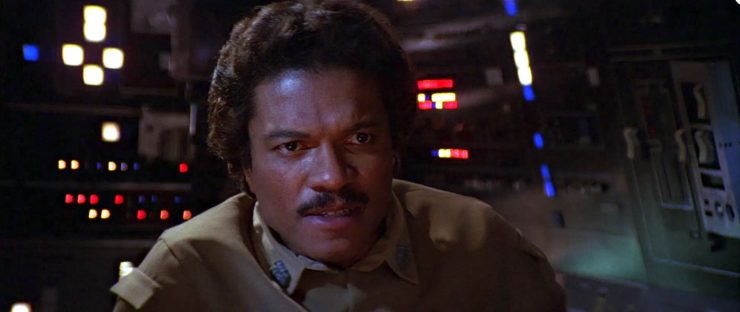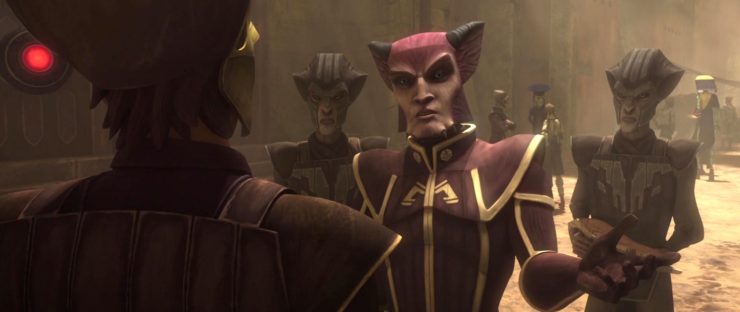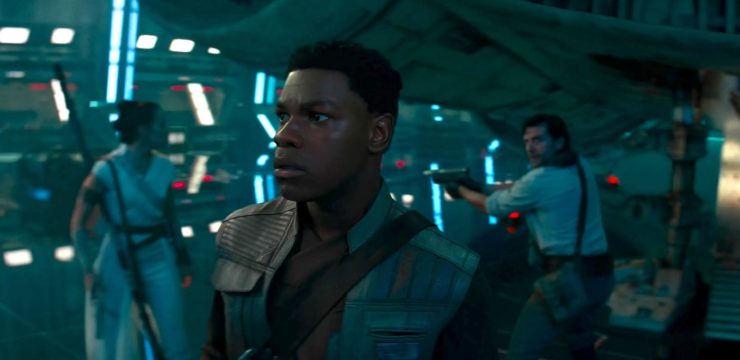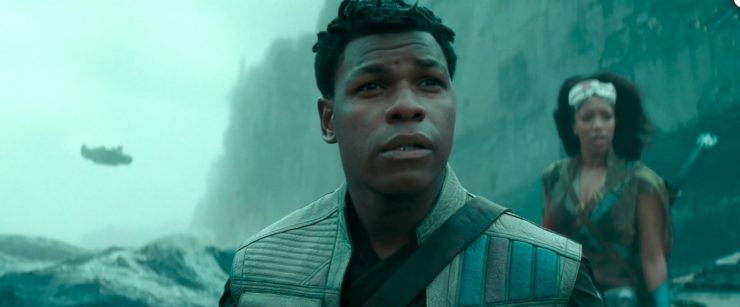We often talk about the value science fiction and fantasy can offer us in the form of allegory. This literary device gives us the ability to talk about real world problems through a filter: the story condemns fascism, but the fascists are elves; the story takes on racism, but the bigotry we see is leveled at a tentacled alien rather than a human; the story wants to show you the indignities perpetrated by sexism, but it offers up a society where men are the oppressed gender. We view events through this filter and ostensibly learn something about our own world, our own failings and shortcomings, and hopefully emerge with greater empathy and a desire to do better.
But the trouble is, allegory can always be ignored by the people who need to internalize it the most.
John Boyega spoke at a Black Lives Matter protest in London on June 3rd, and when he did, the Star Wars actor was aware of the risks inherent in making his voice heard: “I am speaking to you from my heart. Look, I don’t know I’m going to have a career after this, but fuck that.”
Actors and directors rushed to Twitter to support him, including Star Wars director J.J. Abrams. Then Lucasfilm formally made a statement, claiming solidarity with his speech: “John Boyega, you are our hero” was the final sentence. How a person can be hero to a company is a thought exercise we should perhaps reserve for another day, but it is important to note that nowhere in the Lucasfilm statement was there a call to action, or an indication of what the company planned to do in standing with the actor. They seemed to believe that their words were enough, or maybe they thought that in being the film company responsible for Star Wars, their record against oppression spoke for itself.
We stand with and support you, @JohnBoyega. View his full speech: https://t.co/Goxb5y2wrK pic.twitter.com/ZvE0t5tRPY
— Star Wars (@starwars) June 3, 2020
Star Wars, as it stands, is a story about resisting fascism and empire. But it does not take place in our galaxy, with our shared history attached, at least not in a literal sense. To be more precise, it is a modern myth steeped in allegory: droids are treated as slaves; shrouded aliens stand in for indigenous peoples; planet-killing lasers take the place of nukes and biological weapons. Without reliance on allegory, Star Wars wouldn’t have much of a story to tell.
Recently, there have been authors and fans who have come forward against allegorical storytelling in the place of actual representation—it’s one thing to have an allegory for the horrors carried out against queer people due to homophobia, but if your story contains no actual queer characters, then how are you helping to solve the problems perpetuated by homophobic institutions and systems? Allegory as set dressing does little to address the imbalances of our world as we currently find it… and it can also make it easier for people to bypass your message if it functions in a manner totally disconnected from our reality.
Which makes things extremely awkward for a franchise like Star Wars.
I bring this up not because it’s new—fans of Star Wars and pop culture scholars have been aware of this particular thorny problem for decades—but because the more Star Wars content that Lucasfilm (and now Disney) produce, the more we are able to distance ourselves from what that allegory was trying to impart in the first place. While there are aspects of Star Wars that appear to get better in terms of replacing allegory with true representation as time goes on, there are other ways in which Star Wars has gone fundamentally backwards on that count. And if Lucasfilm is going to claim to support Boyega in his fight for a world where Black lives truly do matter, perhaps they could start there.
Here are the facts as we find them: The first Star Wars film has no Black people in it, save the voice of James Earl Jones, who is voicing a white character. The second Star Wars film has one Black person in it, and he betrays his old friend to Darth Vader in service of peace for the city he manages. But something fascinating happens by the third film: While the cast is still overwhelmingly white, when we watch the Battle of Endor, we can see that there are a few people of color among the Rebel Alliance ranks (they are fighter pilots), and also a few aliens, and women. The Empire, on the other hand, is entirely staffed by white men (who are mostly British because Americans are still stuck on the idea that Britain = empire as though the United States has never done anything remotely imperialist, but I digress).

According to what we see in the original Star Wars trilogy, the Empire is a xenophobic organization, but it is also undoubtedly a white supremacist one as well. And that wasn’t a flaw in the makeup of the story—if you’re going to champion one sort of prejudice, why wouldn’t you champion all the other sorts too? Prejudicial beliefs often go hand in hand, they feed and sustain each other. But more to the point, it made the allegory of Star Wars much clearer to anyone who might try to deny it. The bad guys are a homogeneous group, while the good guys are less homogeneous. They have a fish for a commander, don’t forget.
Then Star Wars expanded through the prequels, and eventually a few television shows, and a new canon of books and games, and then another trilogy for a new generation. As the story grew, there were more roles for people of color, and more Black characters, but another key change emerged—suddenly, the Empire wasn’t only staffed by white men. And there is a certain amount of logic is this decision, of course: in a galaxy far, far away, the idea of an evil Empire taking its ire out on different alien species and reserving its ranks for humans arguably makes more sense. But this shifted the allegorical nature of Star Wars. Suddenly, any human could be a member of the Empire or the First Order, and participate in fascism and genocide. Characters like Rae Sloane (introduced in the 2014 novel A New Dawn) and Bodhi Rook (Rogue One) have changed the makeup of the story permanently in this regard, and that will in turn change how people absorb the rhetoric and metaphors enmeshed in Star Wars.
It gets worse, though. The prequels show us that Anakin Skywalker started his life as a slave, but slavery in the Star Wars narrative operates on two fronts—with droids, which all organic beings seem to treat as slaves with very little thought toward the matter, and with sentient beings, who are largely bought and sold by non-humans. Anakin and his mother were owned by a Toydarian junk seller named Watto, who won them in a bet from Gardulla the Hutt. These are aliens who own humans as slaves, and while the Empire has its own slaving practices (they treat the Wookiees as slave labor, as we see with Chewbacca in Solo), it’s relevant that we never see humans owning other humans. It’s clearly possible—Cliegg Lars frees Anakin’s mother to marry her after purchasing her from Watto—but the closest we get are the First Order’s brainwashing of its soldiers, and the Republic’s ownership over clone troopers, which are never framed in terms of slavery despite functionally being such.

This is how the allegory becomes twisted and tells a very different story. It’s not that Star Wars is refusing to acknowledge slavery—it’s that the narrative keeps doing so at an ever-widening remove. That distance seems to get more and more pronounced over time, and that’s a choice that the people making Star Wars have made.
Nowhere does this problem come more clear than in the canonization of the Zygerrian empire in the Clone Wars television series. In a trilogy of episodes in the show’s fourth season, we learn that Ahsoka’s people, the Togruta, have been kidnapped by the Zygerrians—the species largely responsible for slavery in their galaxy. The Zygerrians ran a massive slave trading empire for millennia, but we’re told that the Jedi went to war with them over it and the Republic eventually outlawed the practice. This gave the Zygerrians motive to join the Separatists in the Clone War, and they attempt to restart their slave trade once they give their allegiance to that cause. During these episodes, we get an exchange between Ahsoka and Anakin about the Zygerrian people:
“How can a civilization this advanced still practice slavery?”
“It makes them wealthy and powerful at the expense of others.”
It’s on the nose, but it makes the point. The Zygerrians are the most direct analog Star Wars has to the historical Atlantic slave trade—their slaves are bought and sold in markets and referred to as stock, they steal people from their homes and transport them far away, they use whips to enforce “discipline,” and the practice is maintained for economic purposes.
But they’re modeled off coyotes.
This is not a joke—rather than have a sizable human empire responsible for slavery in the Star Wars galaxy, the Zygerrians are an alien species that resemble coyotes in their facial features. According to video commentary for these episodes, the association with coyotes was meant to make viewers find them more unscrupulous and cunning, as coyotes have the reputation for mischievousness in other fictional narratives. There are a number of issues with this particular decision (“mischief” certainly isn’t a quality that readily comes to mind when thinking about slave traders, just to start), but I’ll bring it back around to the primary problem at hand: yet again, Star Wars chose to frame slavery as an alien-on-alien institution. Again, the allegory can be viewed from a chasmic distance that appears to have no bearing on our current reality.

Does it matter that the majority of the leaders within the Empire and the First Order are white men? Of course it does. But the result leaves fanatical regimes led by fascist dictators looking more like modern day corporations than the examples of authoritarianism and imperialism that they are meant to stand in for. The Board of Directors is white, but look, some of the entry level positions are filled by people of color. Upper management is all straight, but you can find some queer people sprinkled throughout the ranks. The CEO is a man, but one of the VPs is a lady! The Galactic Empire can have a little diversity, as a treat.
Star Wars doesn’t know how to reckon with what it built. It doesn’t know how to handle the fact that the Republic’s clone army are all duplicated off a Maori man, or that Elthree fights for droid emancipation only to end up imprisoned in the Millennium Falcon’s computer banks, or the fact that Finn is functionally a slave who escapes the people who proclaim to be his masters. Robert Daniels says it best in his essay for Polygon, “John Boyega is doing what Star Wars wouldn’t”:
A fulfillment of Finn as a revolutionary doesn’t actually arrive until he teams with the other disaffected stormtroopers during the final act of the final film of the trilogy. By that point, the promise of these newer chapters addressing race and representation, taking relevant cues from Black Lives Matter in the process, were all but extinguished by the franchise’s previous entries. There’s no time for Finn and Jannah to bond over their identities, to share experiences with Lando, to explore how young Black voices look toward movements of the past for guidance today. Finn, Jannah, and Lando don’t get to be Black.
Daniels is correct and it’s a shame because allegory is only as good as the representation built alongside it. If Finn and Jannah and Lando don’t get to be Black, then all Star Wars gives us is an allegory. An allegory that sees aliens responsible for slavery, and robots who are oppressed, and an Empire that counts itself as an “equal opportunity” employer. And where, exactly, does that leave us?

It’s easy to say that allegory is a useful tool in teaching morality, but if it were truly doing the job for us, then the only Star Wars fans would be anti-racist. Sadly, we have plenty of evidence to the contrary, which is precisely what makes Lucasfilm’s statement of solidarity ring hollow. Their corporation may not be built for the work of resistance—but John Boyega can’t wait for them to catch up.
Emmet Asher-Perrin would would appreciate if Lucasfilm offered up something more than words. You can bug them on Twitter, and read more of their work here and elsewhere.










